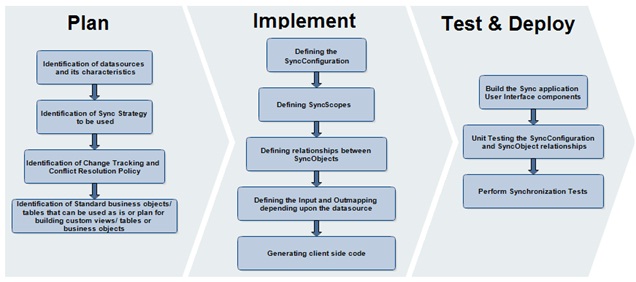
Kony Fabric

Data Synchronization application development is not different from the normal software development. Therefore, the best practices for a successful software development also apply to Data Synchronization application development. However, it is also useful to be aware of the additional best practices for the effective and efficient Kony Fabric Sync application development. The key factors for a successful Kony Fabric Sync application development are as follows:
Some of the most important artifacts in the planning phase are as follows:
One of the key decisions in the planning phase is to identify the business objects in the backend system and to decide how they are represented in the client application. Since one of the core functions of an Kony Fabric Sync application is that the business objects updated on a client device is successfully uploaded to a backend system and vice versa, it is very important to identify which business object in a backend system can be used and to identify the dependencies of the business objects on other objects. The identification of the business objects is typically followed by the identification of existing Database Tables, Web Service End Points or SAP BAPIs.
On the client side, the same business object identification process is required based on the requirements. It is especially important to identify whether the downsized or merged version of the business objects in a backend system can be used.
In most cases, the backend wrappers are responsible for absorbing the differences between the client-side business objects and those in a backend system. However, if they are greatly different, it should be carefully investigated whether backend wrappers can really absorb the differences.
Since the GUI requirements of client applications can differ greatly from an application to another depending on the target application users, it is advisable to conduct a preliminary usability test with potential users of the application and to agree on the GUI design and navigation model used in the application as early as possible.
Finally, before moving on to the first development cycle, it is worth planning which use cases will be covered in each development cycle (For more information, refer to Iterative / Use Case Driven Development).
In each development cycle in the implementation phase, the client- and server-side components can be developed in parallel. However, it is important to be aware of the following dependencies:
For efficient parallel development, therefore, it is important to plan the activities accordingly taking these dependencies into account.
At the end of each development cycle, it is important to conduct the integration / synchronization test, which should include the following:
Performing the integration / synchronization test at the end of each development cycle is beneficial because it makes it possible to identify issues and risks that should be addressed in the next development cycle.
After the completion of all the development cycles and testing, SyncObjects and backend wrappers are moved to the production system.
Below are the test case scenarios that need to be covered for each of the SyncObjects
|
Copyright © 2012 Kony, Inc. All rights reserved. |